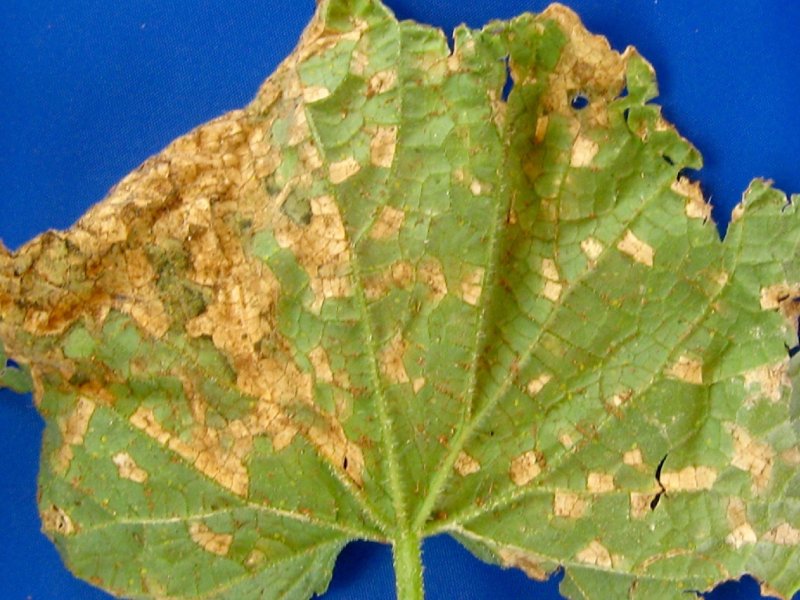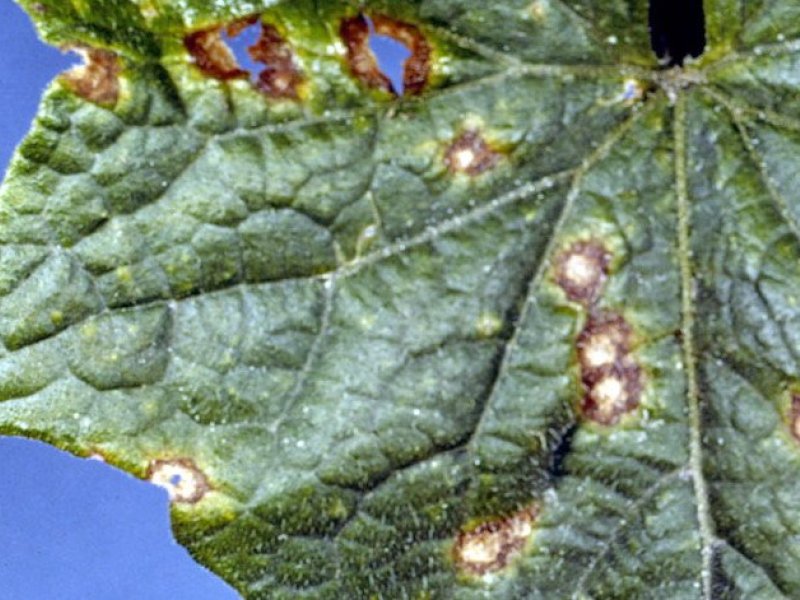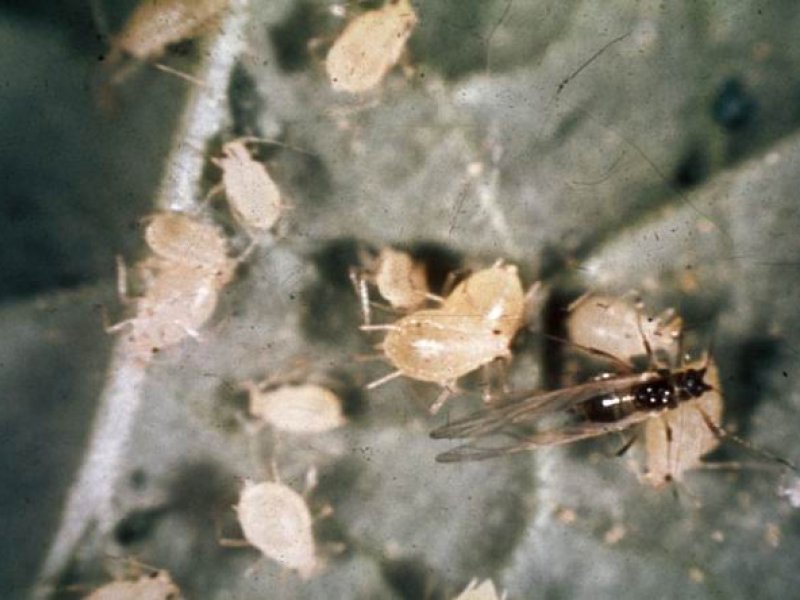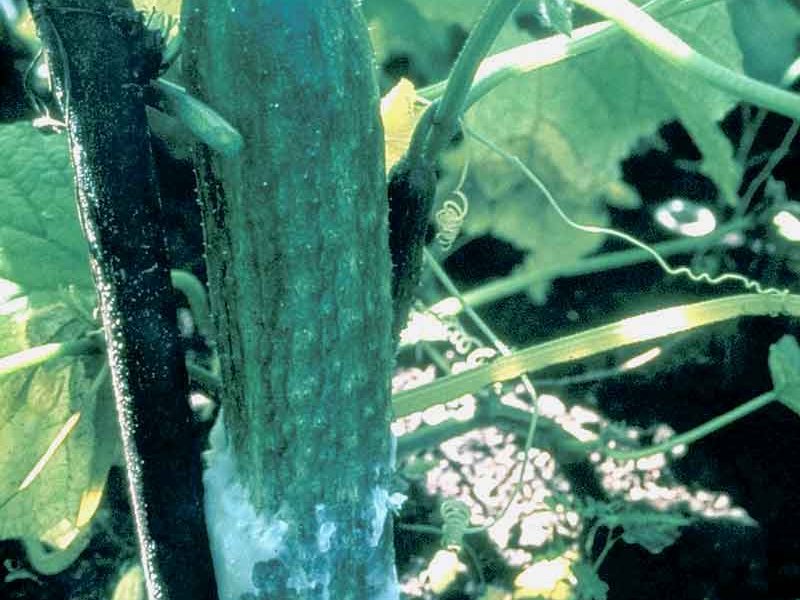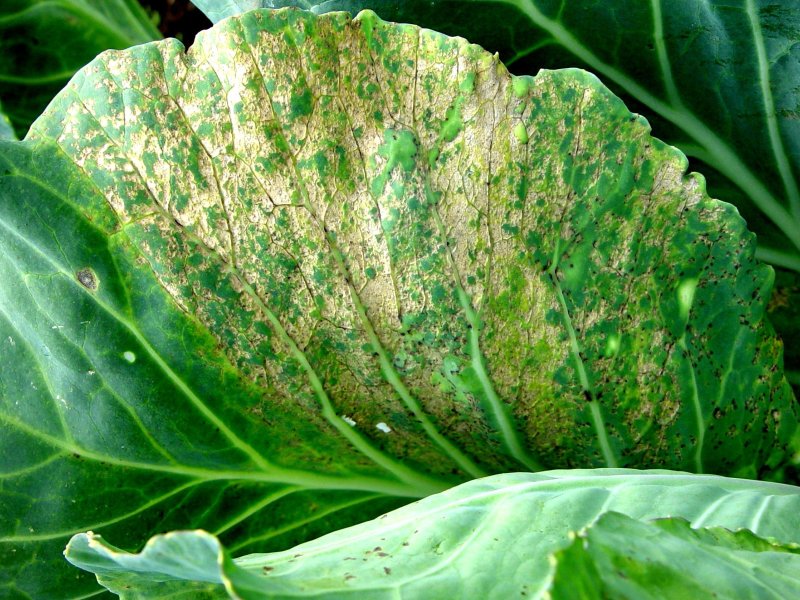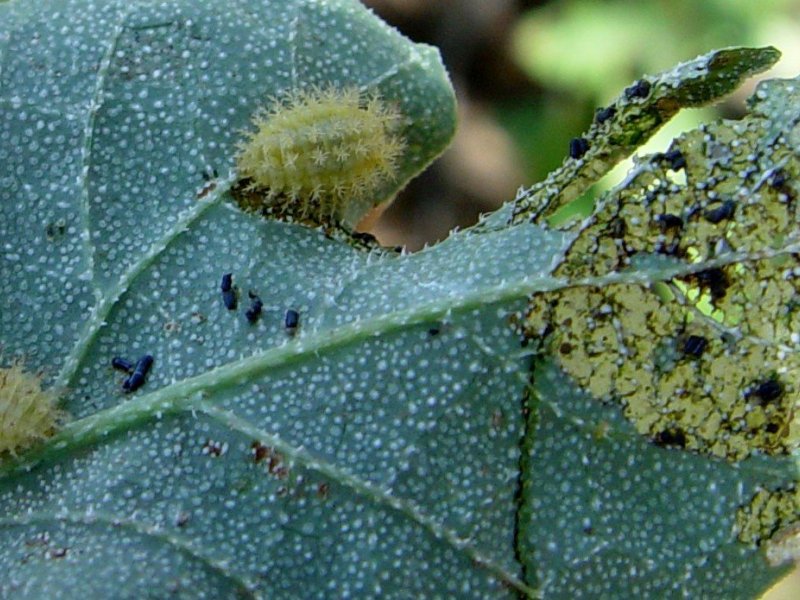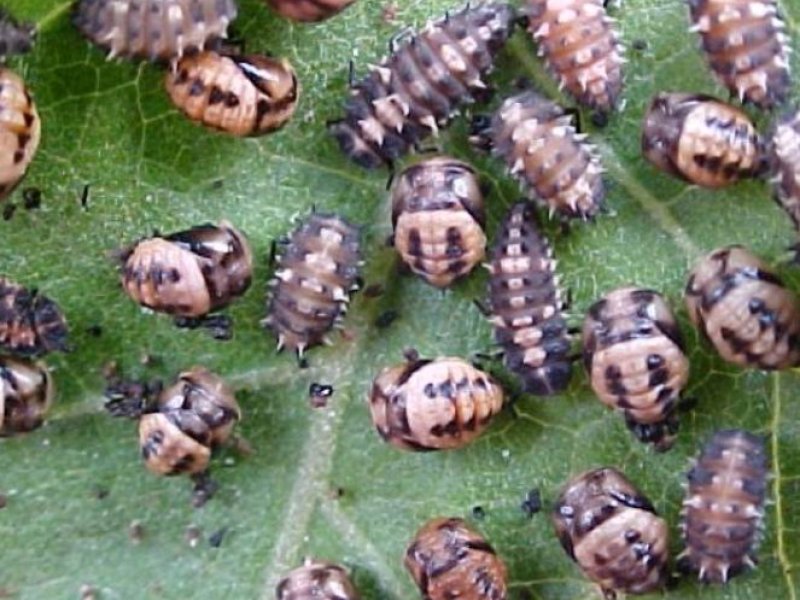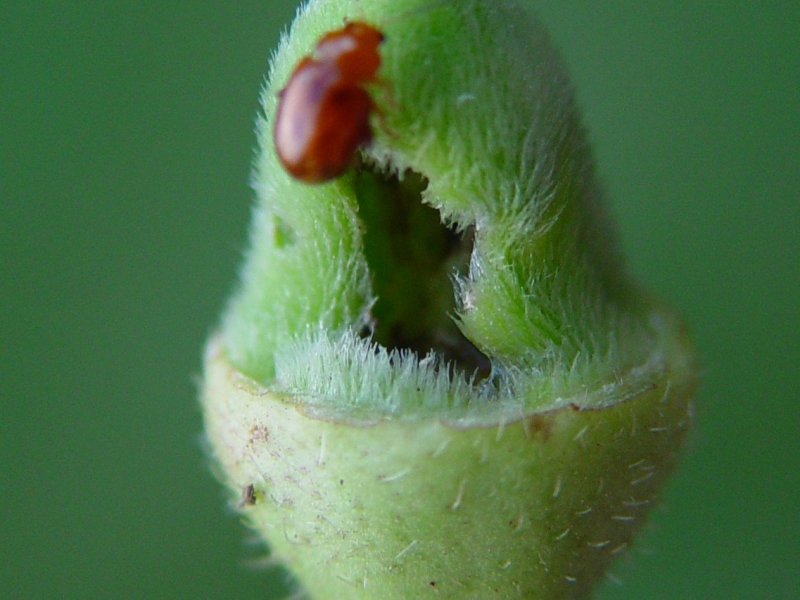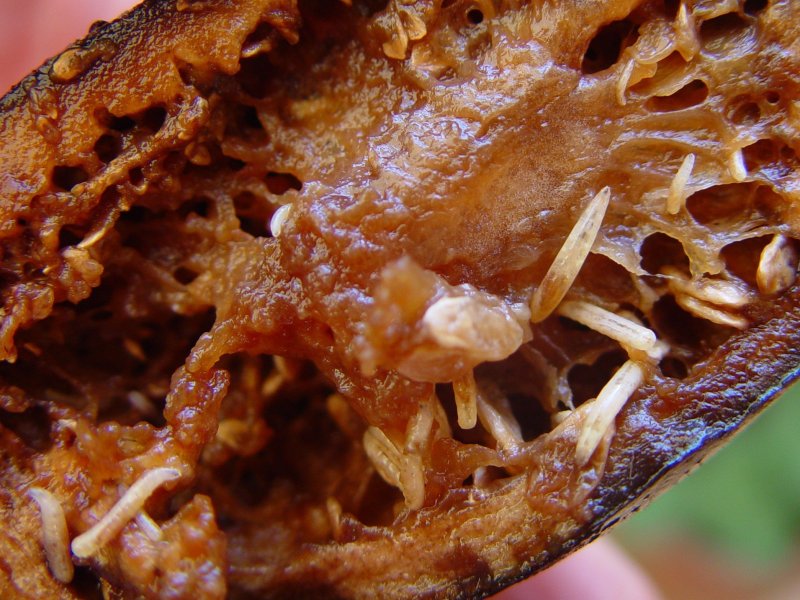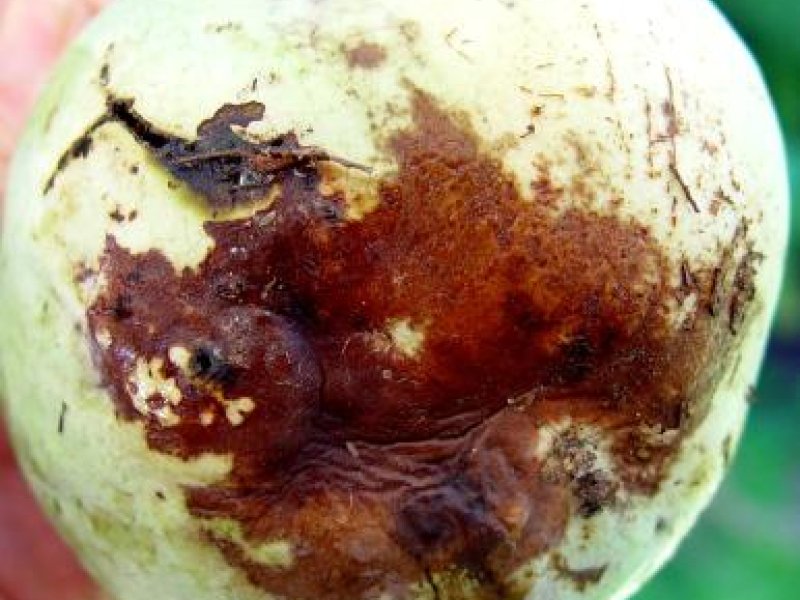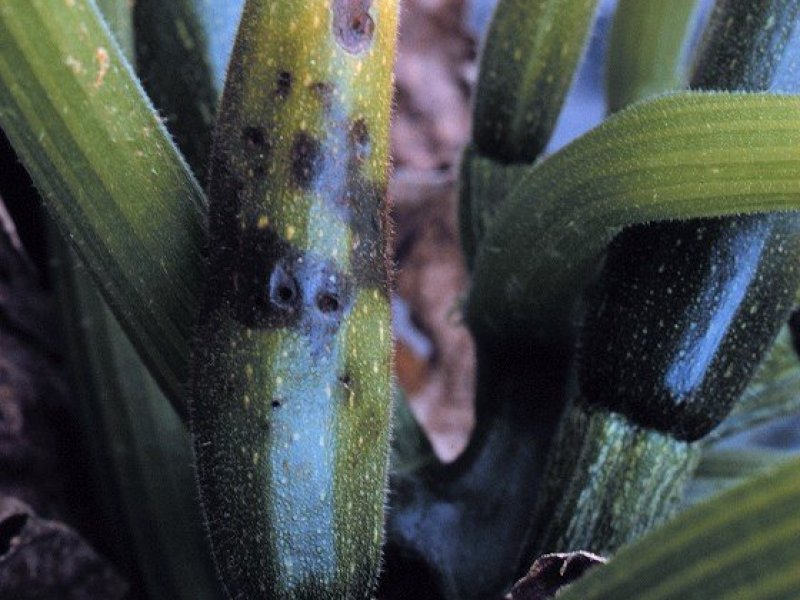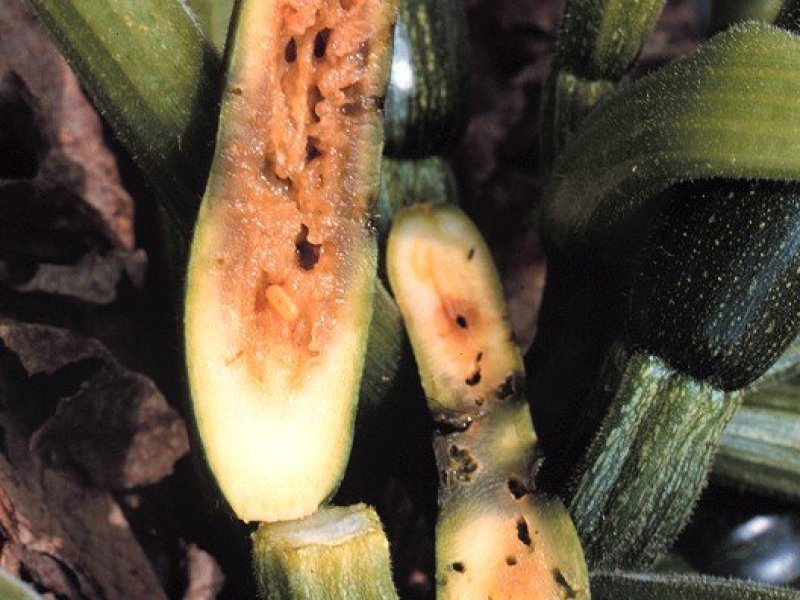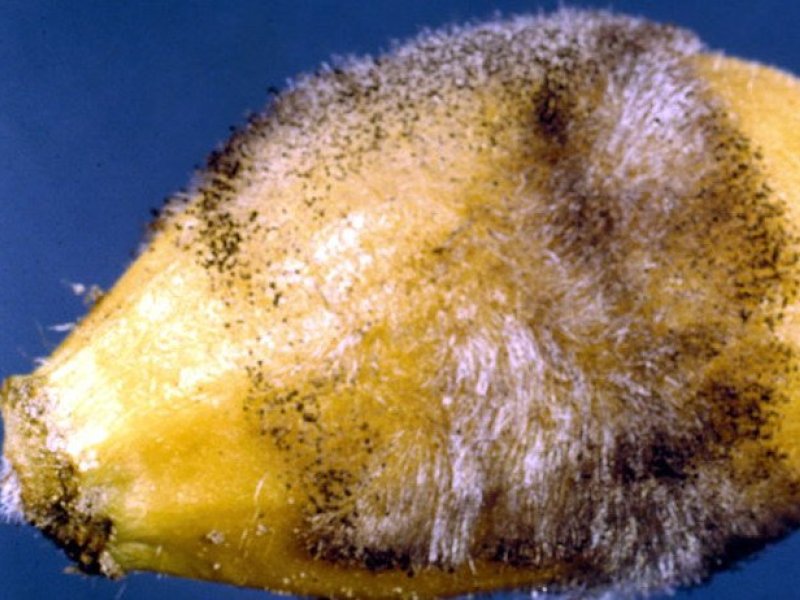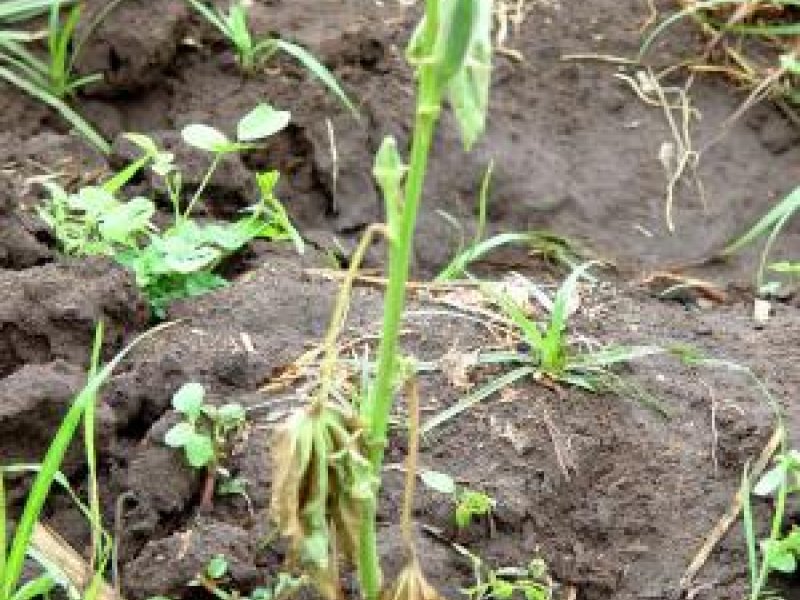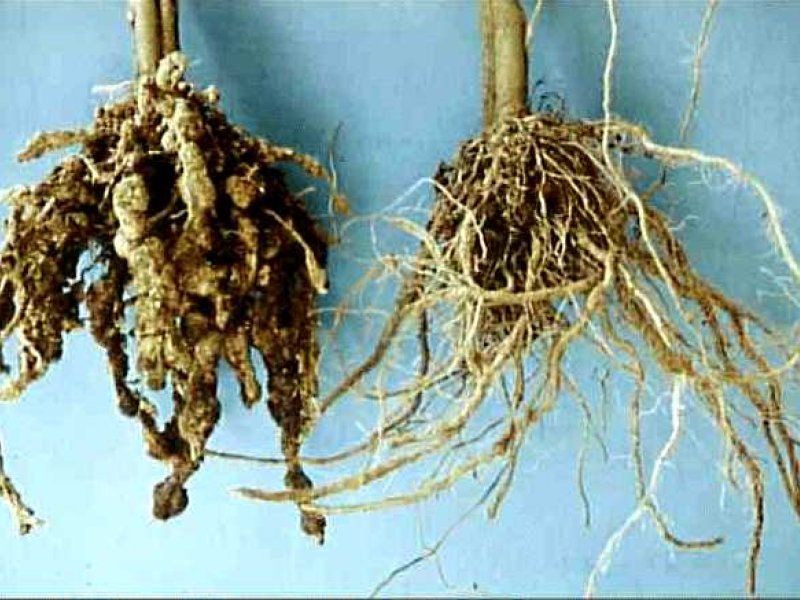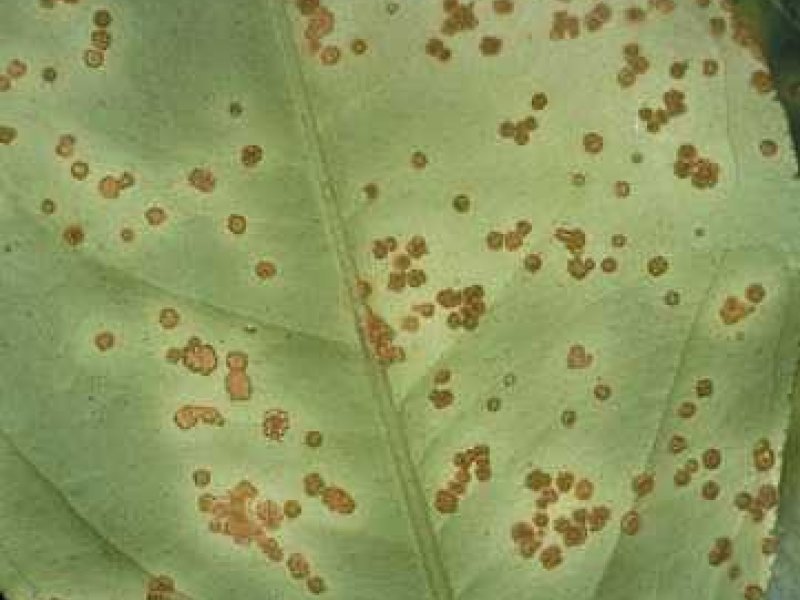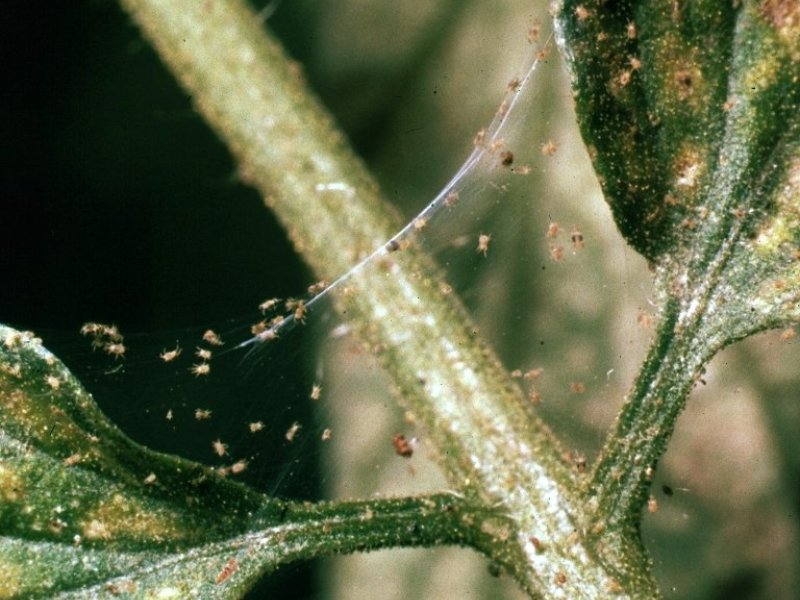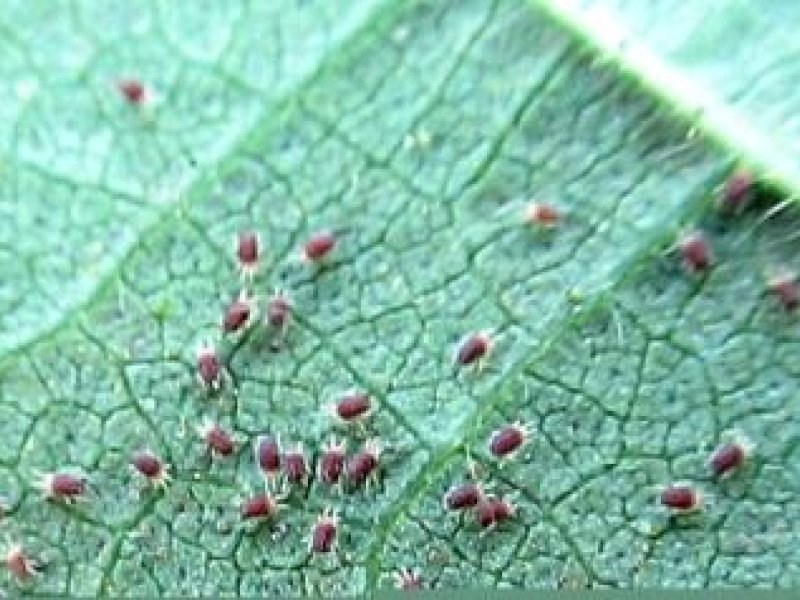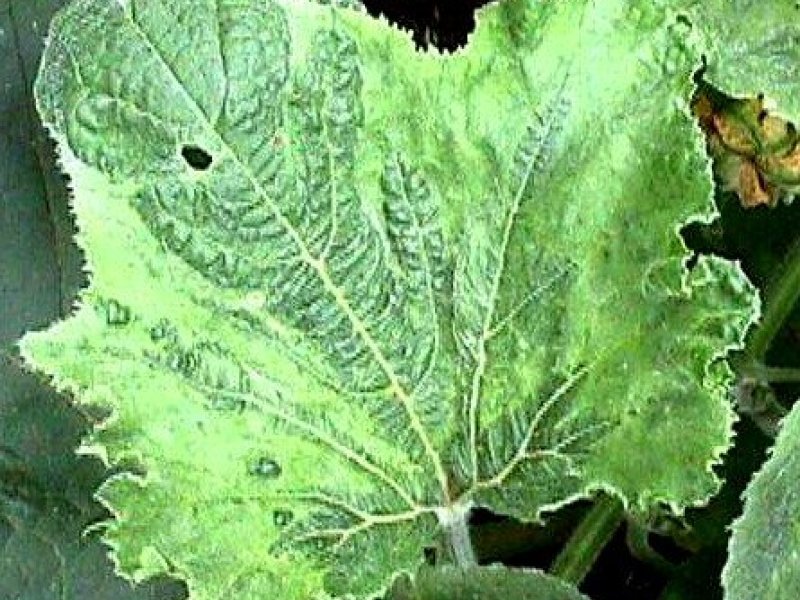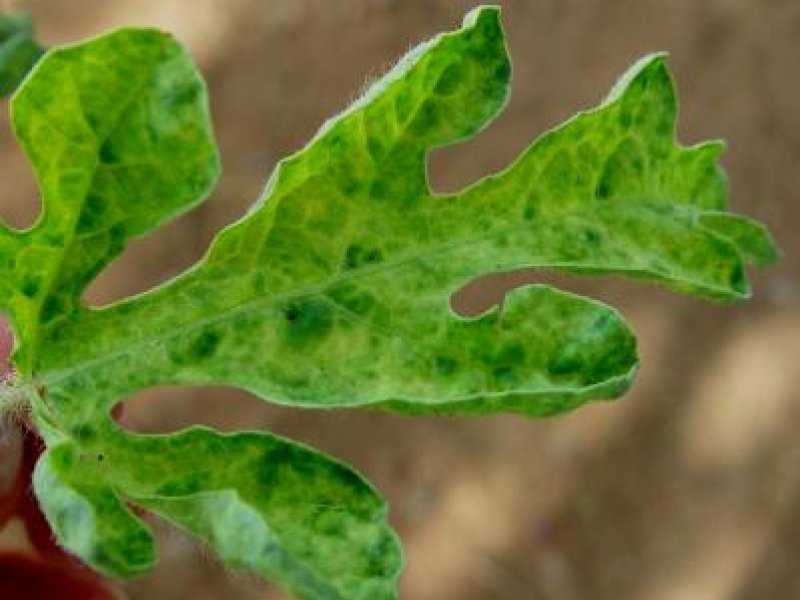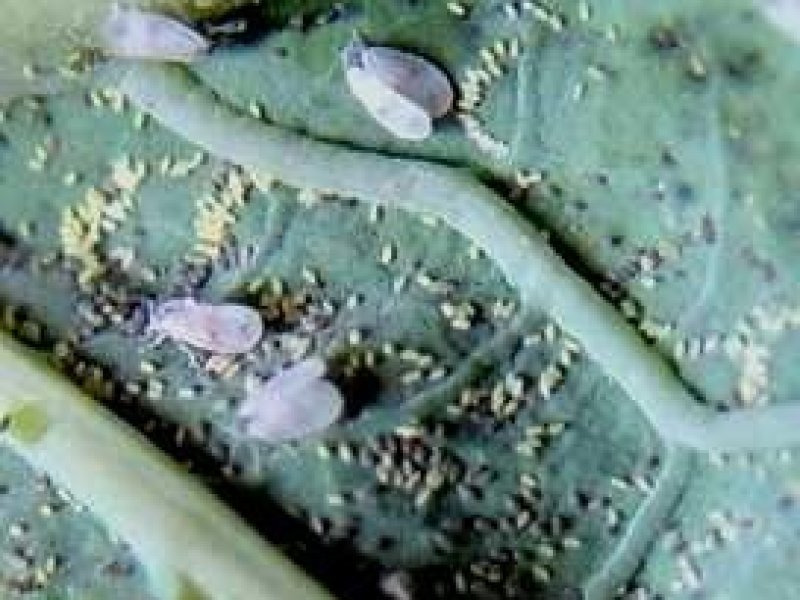|
Angular leaf spot (Pseudomonas syringae pv. lachrymans) Spots on leaves are angular in shape and variable in size due to leaf veins that limit their enlargement. Initially, spots are water-soaked. In moist weather, bacteria ooze from the spots in tear-like droplets, which dry making the tissue white. Affected leaf dries and shrinks, and it may tear away from the healthy portion leaving irregular holes. Leaves approaching maturity are more susceptible than older leaves. Fruits may also be attacked. Fruit spots are small, nearly circular and superficial. The bacteria survive in association with seed. When infected cucumbers are used for seed extraction, the seed can be contaminated during fermentation process. The bacteria can also survive in soil or infected crop debris. Drainage water can spread the bacteria in the soil. Angular leaf spot disease is favoured by wet conditions, frequently associated with rainfall and overhead irrigation. Optimum temperature for disease development is 23.9 to 27.8 degC. The disease attacks gherkin, muskmelon, pumpkin, squash, vegetable marrow and watermelon. |
|
|
What to do:
|
|
Anthracnose (Colletotrichum orbiculare) It is a very destructive disease. It causes defoliation and lesions on the fruits. The fungus can attack all the above-ground plant parts. Cotyledons (seed leaves) of affected seedlings droop and wilt. Lesions (elongated spots) may form on stems of affected seedlings near the ground. Spots on leaves start as small yellowish areas that enlarge and turn brown. The affected tissue dries, breaks and the whole leaf dies. On vines, the spots are elongated and may kill the vines. Symptoms are most noticeable on fruits. Spots on fruits are circular, black, and sunken. When wet, the centres of the spots become salmon coloured due to a mass of fungal spores. Affected fruits can be destroyed by secondary soft-rot organisms, which enter through broken rind. The fungus is seed-borne. It can survive in crop debris and in weeds belonging to the cucurbit family. Fungal development is promoted by wet conditions, high relative humidity and moderate temperatures (20 to 23.9°C ). Its host range includes cucumber, gherkin, gourd, muskmelon, and watermelon. Cucurbit weeds can also be attacked. |
|
|
What to do:
|
|
Aphids (Aphis gossypii) The cotton aphid (Aphis gossypii) is common on cucurbits, including cucumber. Colonies of green to blackish aphids are found on tender shoots, mainly on the lower leaf surface, where they suck sap. The growth of the attacked shoots is stunted and the leaves are curled and twisted. Aphids excrete honeydew, which leads to growth of sooty mould, and may attract fruit flies. Aphids, in particular winged aphids, transmit virus diseases (e.g. cucumber mosaic virus) when moving from plant to plant.
|
|
|
What to do:
|
|
Damping-off disease Damping-off diseases are caused by a complex of plant pathogens (disease inciting agents) including Alternaria spp., Fusarium spp., Pythium spp. and Rhizoctonia solani. These pathogenic fungi may cause rotting of seeds before emergence or death of seedlings after emergence. The most disposing factors are use of non-certified seeds and excessive watering of seed-beds or field plots. |
|
|
What to do:
|
|
Downy mildew (Pseudoperonospora cubensis) Symptoms on leaves appear as small, pale-yellow areas on upper leaf surface. Under humid conditions, a purplish, grey whitish growth may be seen on the underside of the yellowish spots. Affected leaves curl, shrivel and die. |
|
|
What to do:
|
|
Epilachna beetles (Epilachna chrysomelina) Adults of this beetle, also known as the African melon ladybird, are 6-8 mm long, reddish in colour with a number of black spots on the wing cases. The larvae are 7-9 mm in length, soft and covered with dark coloured spines. Adults and larvae feed on leaves leaving a fine net of veins. Damaged leaves shrivel and dry up. Young plants can be entirely destroyed. Older plants can tolerate considerable leaf damage. This beetle is a vector of squash mosaic virus. Epilachna beetles attack all cucurbits. |
|
|
What to do:
|
|
Flea beetles (Podagrica spp) They are 1.5 to 3 mm long with well-developed hind legs. They are named for their habit of jumping like fleas when disturbed. The colour of the adult beetles varies from black, brown, black and yellow striped or metallic blue-green depending on the species. Adult flea beetles chew small round holes (shot holes) in leaves, giving them a sieve like appearance. On rare occasions, they may feed directly on ripe fruit, just below the calyx. This damage is usually seen only in plants that show extreme foliar stress resulting from lack of water or powdery mildew. The larvae of flea beetles live in the soil and feed on roots, but the damage caused is not of economic importance. Adult flea beetles can be particularly damaging to young plants. Seedlings are most vulnerable to flea beetle feeding when stressed, particularly by inadequate moisture. Older plants can withstand considerable leaf perforation.
|
|
|
What to do:
|
|
Fruit flies (Bactrocera cucurbitae, Dacus spp and Ceratitis capitata) Fruit flies are important pests of cucumber and other cucurbits.
Fruit flies are about 4-7 mm long, they pierce the fruits and lay eggs in fruits. The fruit fly maggots feed inside the fruit causing sunken, discoloured patches, distortions and open cracks. These cracks serve as entry points for fungi and bacteria, causing fruit rot.
|
|
|
What to do:
|
|
Fruit rot Fruit rots are of minor importance in Africa; they are primarily post-harvest problems during storage. In most African countries, cucumbers are sold fresh from farm, consumed and are hardly stored for long (exception could be supermarkets in urban areas where fruits are kept on shelves).
|
|
|
What to do:
|
|
Fusarium wilt The lower leaves of the plant usually turn yellow and die. One or more branches may exhibit such symptoms. Leaflets on one side may be affected while those on the other side are symptomless. Diseased leaves readily break away from the stem. When affected stems just above ground level and petioles are cut diagonally, a reddish-brown discolouration of the water conducting tissues will be observed. The fungus is both seed- and soil-borne. It causes most damage on light, sandy soils. It is most active at temperatures between 25 and 320C. The fungus can survive in the soil indefinitely even when no tomatoes are grown. It can also survive in fibrous roots of weeds (e.g. Amaranthus, Digitaria and Malva species). Acidic soils (pH 5.0 to 5.6) and excessive nitrogen fertilisation promote disease development. Infestation by root-knot nematodes encourages the disease. |
|
|
What to do:
|
|
Root-knot nematodes (Meloidogyne spp.) Symptoms of infestation by root-knot nematodes are similar in all crops: wilting of plants and if infested plants are pulled from the soil the roots can be seen to be distorted, swollen and bearing knots. The infested roots eventually rot and affected plants die.
|
|
|
What to do:
|
|
Scab (Cladosporium cucumerinum) It attacks all aboveground plant parts. Initial symptoms on leaves appear as light water-soaked or pale green spots. The spots are numerous and can appear on and between veins. Elongate spots may develop on petioles and stems. The spots later turn grey to white and become angular. The fine veinlets in the spots may be brown and are distinct against a white background. Dead leaf tissue cracks and breaks away until the whole leaf is ragged. Fruits can be attacked at all stages of growth. However, young fruits are most susceptible. Plant tissue near the spots may produce sap, initially watery but later becomes gummy to hard. The fruit spots are cankerous and with time become darker, sunken until a pronounced cavity is formed. Under moist weather, a dark-green velvety layer of fungal growth appears on the cavities. The fungus survives in crop debris, soil and on seed. It is spread by insects, farm tools and wind. The disease is most severe at 100% relative humidity and at relatively cool temperatures (21-25°C). Its host range includes cantaloupe, gherkin, muskmelon, pumpkin, squash and watermelon.
|
|
|
What to do:
|
|
Red spider mites (Tetranychus spp.) Red spider mites attack leaves of cucumber. Adults are about 0.6 mm long. Attacked leaves have a stippled appearance, turn yellowish to whitish and dry up. Often young plants are entirely destroyed. In older plants growth can be severely stunted and the fruit set considerable reduced. Spider mites can be a problem in dry and hot conditions. Plants under water stress (drought) are more likely to suffer damage by spider mites. |
|
|
What to do:
|
|
Mosaic Virus diseases Cucumber mosaic virus It is not seed transmitted except through seed of perennial wild cucumber (Echinocytis lobata) and chickweed (Stellaria media). It is mechanically transmitted and in nature it is spread by various species of aphids. It has a very extensive host range including such varied species as bananas, carrots, cowpeas, lupine, lilies, onions, passion fruit, potatoes and tomatoes.
Watermelon mosaic virus This virus is mechanically transmitted and also spread by several species of aphids. It is not seed transmitted. Its host range is primarily restricted to cucurbits although one of its strains infects peas.
Squash mosaic virus It is mechanically transmitted. It is transmitted through seeds of melons and squash. It is also transmitted by spotted, striped and banded cucumber beetles, which attack cucumbers in the Americas. The Epilachna beetle (Epilachna chrysomelina) a pest of cucumber in Africa, is also vector of squash mosaic virus. Its host range includes cucurbits, peas, coriander, and salad chervil.
|
|
|
What to do:
|
|
Whiteflies (Bemisia tabaci) They suck plant sap and excrete honeydew where moulds grow, which may affect plant growth and vigour. The tobacco whitefly is considered a major pest due to its ability to vector various virus diseases, which cause considerable damage to cucurbits.
|
|
|
What to do:
|
Geographical Distribution in Africa
Geographical Distribution of Cucumber in Africa. Updated on 8 July 2019. Source FAOSTAT
General Information and Agronomic Aspects
Cucumber is a member of the Cucurbitaceae family, which includes pumpkins, squash, gourds and zucchini. Cucumber is grown for the immature fruits, which are eaten fresh (slicing cucumber), or used for pickles (pickling cucumber) . The slicing cucumbers are peeled, sliced and served with vinegar or dressing, or as an ingredient of salads. The large, yellow, round types are boiled and eaten as an ingredient of stews. Pickling cucumbers are preserved or marinated with vinegar, salt, or spices. They can also be used fresh. Cucumbers are a good source of vitamin C.
Nutritive Value per 100 g of edible Portion
| Raw or Cooked Cucumber | Food Energy (Calories / %Daily Value*) |
Carbohydrates (g / %DV) |
Fat (g / %DV) |
Protein (g / %DV) |
Calcium (g / %DV) |
Phosphorus (mg / %DV) |
Iron (mg / %DV) |
Potassium (mg / %DV) |
Vitamin A (I.U) |
Vitamin C (I.U) |
Vitamin B 6 (I.U) |
Vitamin B 12 (I.U) |
Thiamine (mg / %DV) |
Riboflavin (mg / %DV) |
Ash (g / %DV) |
| Cucumber with Peel raw | 15.0 / 1% | 3.6 / 1% | 0.1 / 0% | 0.7 / 1% | 16.0 / 2% | 34.0 / 2% | 0.3 / 2% | 147 / 4% | 105 IU / 2% | 2.8 / 5% | 0.0 / 2% | 0.0 / 0% | 0.0 / 0% | 0.0 / 2% | 0.4 |
*Percent Daily Values (DV) are based on a 2000 calorie diet. Your daily values may be higher or lower, depending on your calorie needs.
Climatic conditions, soil and water management
Cucumber requires a warm climate. The optimum temperature for growth is about 30°C and the optimum night temperature 18-21°C. In the tropics, elevations up to 1700 m appear to be suitable for cucumber cultivation. A lot of light tends to increase the number of staminate (male) flowers. Cucumbers need a fair amount of water but they cannot stand waterlogging. High relative humidity encourages downy mildew. The soil should preferably be fertile and well-drained, with a pH of 6.5-7.5. Long and medium long slicing cucumber varieties are grown in greenhouses where climate and other growing conditions can be controlled.
Propagation and planting
Cucumber is propagated by seed. Soil preparation requires generous incorporation of well rotted manure. About 30 t/ha or 15 tons/ha should be applied inside the planting holes together with a spoonful of rock phosphate (3 tea spoons) for each planting hole. Sowing is done directly in the field with several seeds per hill, 90-120 cm apart, then thinned to 2-3 plants per hill, or seeds are sown in nursery beds and seedlings transplanted to the field at the 2-true-leaf stage at 30-40 cm within and 1-2 m between the rows. Sowing rates per ha are about 2.5-3 kg for direct seeding and 1 kg when transplanted. Cucumber cultivated for pickles is planted closer, up to 250,000 plants/ha. For greenhouse varieties plants are started in individual pots and transplanted to permanent position when they have 2-3 permanent leaves.
Cucumber varieties are categorised into four types on basis of fruit length:
- Long cucumbers: Fruit length over 30 cm. Examples: "Berlin RZ", "Bologna RZ", "Cumlande RZ", "Myrthos RZ", "Pluto RZ" "Virginia RZ")
- Midi cucumbers: Fruit length between 18 -24 cm Examples: "Media RZ
- "Mini cucumbers: Fruit length between 15 -19 cm. Examples: "Khassib RZ", "Gianco RZ
- "Cocktail cucumbers: Less than 15 cm. Examples: "Rania RZ"
Other varieties include:
- "Ashley" It takes about 65 days to maturity. Fruit colour is dark green. Fruit shape is long and spined. It has some resistance to downy mildew.
- "Danora F1 Hybrid". It is a long cucumber. It tales about 65 days to maturity. Fruit colour is green. Fruit is elongated. It has good resistance to powdery mildew and leaf spot.
- "Palomar". It takes about about 60 days to maturity. Fruit is dark green. Fruit is long and cylindrical. It has good tolerance to leaf diseases. It is good for pickling.
- "Poinsett". Poinsett is a variety with a very high yield potential, good disease and heat resistance
- ."Sarig". It is dark green in colour. Fruit length of 14-16 cm. It is very smooth and of high quality. It has a long shelf life. It is resistant to powdery mildew. It is suitable for green house production.
- "Super Marketer". Maturity period is 45 to 60 days. It grows well in hot climatic conditions. Its very high yielding about 16-32 t/ha. It is very popular in the local market.
- "Tempo" ("HA 78"). It is dark green in colour. The average fruit length is 30-35 cm. It has a good shelf life of up to 2 weeks. It is resistant to powdery mildew.
- "Toaz". It has a very vigorous growth. Fruit is dark green in colour. Fruit length is 16-18 cm. It is smooth and has a good shelf life, It is suitable for green house production.
- "Long Fellow"
- "Hybrid Victory"
- "Kande" (new variety produced in Tanzania)
Because varieties change all the time, please ask your local seed company to give information about the available varieties.
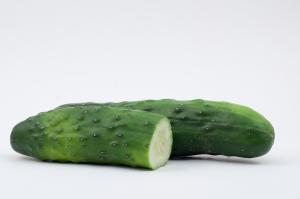 |
| Cucumber |
| © Biovision |
Marketable cucumbers: The two long varieties shown on the left are green house types that need protected environment and careful staking so as not to damage fruits. The two short types on the right can be grown in open fields and without staking. Pickling varieties are even smaller, but also baby fruits of the two field varieties are good for pickling.
Husbandry
Weed control is necessary until the plants cover the soil entirely. Support (stakes) should be provided for some cultivars, and the tip of the main stem can be nipped off to encourage branching. Irrigate at frequent intervals, and maintain a high level of soil moisture throughout the growing period. Lateral shoots can be pruned after the first fruits have formed to limit leaf and flower production. Greenhouse varieties are staked according to preferred practices, usually by means of twisting the growing stem around a string attached to an overhead strong wire. There are indications that irrigation water containing applications of effective micro-organisms (EM) can prevent damping off and early attacks of diseases on leaves.
Irrigation should preferably be applied in the form of drip in order to prevent water splashes and spread of diseases. Staked cucumbers are very susceptible to wind, so if grown in open land should be carefully protected from wind.
Harvesting
Cucumbers for fresh consumption are harvested before they are fully mature, usually starting about 50- 60 days after planting, and thereafter every few days. For pickling, immature fruits of several stages are harvested. Only for seed production are cucumbers allowed to mature on the plant.
Cucumbers should be handled with care as they get damaged easily during transport. Depending on variety one plant may yield up to 10 fruits, and total yields with good plant care can easily reach 50 tons/ ha of the larger fruit types. More common yields are 25-30 tonnes/ha. Fruits should not be left to ripen on the vines as the plants will cease to bear. The marketed fruit must be firm, green and the size typical of the cultivar.
Some of the long slicing cultivars of cucumber are packed individually before marketing and cooled.
| The cotton aphid (Aphis gossypii) is common on cucurbits, including cucumber. Colonies of green to blackish aphids are found on tender shoots, mainly on the lower leaf surface, where they suck sap. The growth of the attacked shoots is stunted and the leaves are curled and twisted. Aphids excrete honeydew, which leads to growth of sooty mould, and may attract fruit flies. Aphids, in particular winged aphids, transmit virus diseases (e.g. cucumber mosaic virus) when moving from plant to plant.
What to do:
|
| Fruit flies (Bactrocera cucurbitae, Dacus spp and Ceratitis capitata) Fruit flies are important pests of cucumber and other cucurbits.
Fruit flies are about 4-7 mm long, they pierce the fruits and lay eggs in fruits. The fruit fly maggots feed inside the fruit causing sunken, discoloured patches, distortions and open cracks. These cracks serve as entry points for fungi and bacteria, causing fruit rot.
What to do:
|
| They suck plant sap and excrete honeydew where moulds grow, which may affect plant growth and vigour. The tobacco whitefly is considered a major pest due to its ability to vector various virus diseases, which cause considerable damage to cucurbits.
What to do:
|
| Epilachna beetles (Epilachna chrysomelina) Adults of this beetle, also known as the African melon ladybird, are 6-8 mm long, reddish in colour with a number of black spots on the wing cases. The larvae are 7-9 mm in length, soft and covered with dark coloured spines. Adults and larvae feed on leaves leaving a fine net of veins. Damaged leaves shrivel and dry up. Young plants can be entirely destroyed. Older plants can tolerate considerable leaf damage. This beetle is a vector of squash mosaic virus. Epilachna beetles attack all cucurbits. What to do:
|
| They are 1.5 to 3 mm long with well-developed hind legs. They are named for their habit of jumping like fleas when disturbed. The colour of the adult beetles varies from black, brown, black and yellow striped or metallic blue-green depending on the species. Adult flea beetles chew small round holes (shot holes) in leaves, giving them a sieve like appearance. On rare occasions, they may feed directly on ripe fruit, just below the calyx. This damage is usually seen only in plants that show extreme foliar stress resulting from lack of water or powdery mildew. The larvae of flea beetles live in the soil and feed on roots, but the damage caused is not of economic importance. Adult flea beetles can be particularly damaging to young plants. Seedlings are most vulnerable to flea beetle feeding when stressed, particularly by inadequate moisture. Older plants can withstand considerable leaf perforation.
What to do:
|
| Red spider mites (Tetranychus spp.) Red spider mites attack leaves of cucumber. Adults are about 0.6 mm long. Attacked leaves have a stippled appearance, turn yellowish to whitish and dry up. Often young plants are entirely destroyed. In older plants growth can be severely stunted and the fruit set considerable reduced. Spider mites can be a problem in dry and hot conditions. Plants under water stress (drought) are more likely to suffer damage by spider mites. What to do:
|
| Root-knot nematodes (Meloidogyne spp.) Symptoms of infestation by root-knot nematodes are similar in all crops: wilting of plants and if infested plants are pulled from the soil the roots can be seen to be distorted, swollen and bearing knots. The infested roots eventually rot and affected plants die.
What to do:
|
Information on Diseases
General Information
Many viruses affect the cucumber family. The important viruses include cucumber mosaic virus, watermelon mosaic virus and squash mosaic virus. Field symptoms of these three diseases are similar and therefore it is very difficult to separate them by symptoms alone. Leaf symptoms include a prominent light and green mosaic pattern, mottling (yellow with green islands or blisters), and in severe cases, leaf distortion whereby affected leaves appear fern-like. Diseased fruits are malformed (slightly to severely misshaped with wart-like lumps).
Examples of Cucumber Diseases and Organic Control Methods
| Damping-off diseases are caused by a complex of plant pathogens (disease inciting agents) including Alternaria spp., Fusarium spp., Pythium spp. and Rhizoctonia solani. These pathogenic fungi may cause rotting of seeds before emergence or death of seedlings after emergence. The most disposing factors are use of non-certified seeds and excessive watering of seed-beds or field plots. What to do:
|
| Downy mildew (Pseudoperonospora cubensis) Symptoms on leaves appear as small, pale-yellow areas on upper leaf surface. Under humid conditions, a purplish, grey whitish growth may be seen on the underside of the yellowish spots. Affected leaves curl, shrivel and die. What to do:
|
| Angular leaf spot (Pseudomonas syringae pv. lachrymans) Spots on leaves are angular in shape and variable in size due to leaf veins that limit their enlargement. Initially, spots are water-soaked. In moist weather, bacteria ooze from the spots in tear-like droplets, which dry making the tissue white. Affected leaf dries and shrinks, and it may tear away from the healthy portion leaving irregular holes. Leaves approaching maturity are more susceptible than older leaves. Fruits may also be attacked. Fruit spots are small, nearly circular and superficial. The bacteria survive in association with seed. When infected cucumbers are used for seed extraction, the seed can be contaminated during fermentation process. The bacteria can also survive in soil or infected crop debris. Drainage water can spread the bacteria in the soil. Angular leaf spot disease is favoured by wet conditions, frequently associated with rainfall and overhead irrigation. Optimum temperature for disease development is 23.9 to 27.8 degC. The disease attacks gherkin, muskmelon, pumpkin, squash, vegetable marrow and watermelon. What to do:
|
| Anthracnose (Colletotrichum orbiculare) It is a very destructive disease. It causes defoliation and lesions on the fruits. The fungus can attack all the above-ground plant parts. Cotyledons (seed leaves) of affected seedlings droop and wilt. Lesions (elongated spots) may form on stems of affected seedlings near the ground. Spots on leaves start as small yellowish areas that enlarge and turn brown. The affected tissue dries, breaks and the whole leaf dies. On vines, the spots are elongated and may kill the vines. Symptoms are most noticeable on fruits. Spots on fruits are circular, black, and sunken. When wet, the centres of the spots become salmon coloured due to a mass of fungal spores. Affected fruits can be destroyed by secondary soft-rot organisms, which enter through broken rind. The fungus is seed-borne. It can survive in crop debris and in weeds belonging to the cucurbit family. Fungal development is promoted by wet conditions, high relative humidity and moderate temperatures (20 to 23.9°C ). Its host range includes cucumber, gherkin, gourd, muskmelon, and watermelon. Cucurbit weeds can also be attacked. What to do:
|
| The lower leaves of the plant usually turn yellow and die. One or more branches may exhibit such symptoms. Leaflets on one side may be affected while those on the other side are symptomless. Diseased leaves readily break away from the stem. When affected stems just above ground level and petioles are cut diagonally, a reddish-brown discolouration of the water conducting tissues will be observed. The fungus is both seed- and soil-borne. It causes most damage on light, sandy soils. It is most active at temperatures between 25 and 320C. The fungus can survive in the soil indefinitely even when no tomatoes are grown. It can also survive in fibrous roots of weeds (e.g. Amaranthus, Digitaria and Malva species). Acidic soils (pH 5.0 to 5.6) and excessive nitrogen fertilisation promote disease development. Infestation by root-knot nematodes encourages the disease. What to do:
|
| Fruit rots are of minor importance in Africa; they are primarily post-harvest problems during storage. In most African countries, cucumbers are sold fresh from farm, consumed and are hardly stored for long (exception could be supermarkets in urban areas where fruits are kept on shelves).
What to do:
|
| Cucumber mosaic virus It is not seed transmitted except through seed of perennial wild cucumber (Echinocytis lobata) and chickweed (Stellaria media). It is mechanically transmitted and in nature it is spread by various species of aphids. It has a very extensive host range including such varied species as bananas, carrots, cowpeas, lupine, lilies, onions, passion fruit, potatoes and tomatoes.
Watermelon mosaic virus This virus is mechanically transmitted and also spread by several species of aphids. It is not seed transmitted. Its host range is primarily restricted to cucurbits although one of its strains infects peas.
Squash mosaic virus It is mechanically transmitted. It is transmitted through seeds of melons and squash. It is also transmitted by spotted, striped and banded cucumber beetles, which attack cucumbers in the Americas. The Epilachna beetle (Epilachna chrysomelina) a pest of cucumber in Africa, is also vector of squash mosaic virus. Its host range includes cucurbits, peas, coriander, and salad chervil.
What to do:
|
| Scab (Cladosporium cucumerinum) It attacks all aboveground plant parts. Initial symptoms on leaves appear as light water-soaked or pale green spots. The spots are numerous and can appear on and between veins. Elongate spots may develop on petioles and stems. The spots later turn grey to white and become angular. The fine veinlets in the spots may be brown and are distinct against a white background. Dead leaf tissue cracks and breaks away until the whole leaf is ragged. Fruits can be attacked at all stages of growth. However, young fruits are most susceptible. Plant tissue near the spots may produce sap, initially watery but later becomes gummy to hard. The fruit spots are cankerous and with time become darker, sunken until a pronounced cavity is formed. Under moist weather, a dark-green velvety layer of fungal growth appears on the cavities. The fungus survives in crop debris, soil and on seed. It is spread by insects, farm tools and wind. The disease is most severe at 100% relative humidity and at relatively cool temperatures (21-25°C). Its host range includes cantaloupe, gherkin, muskmelon, pumpkin, squash and watermelon.
What to do:
|
Information Source Links
- AIC, Nairobi (2003). Fruits and Vegetables Technical Handbook
- AVRDC International Cooperators' Factsheet on Cucurbits www.avrdc.org
- Beije, C.M., Kanyangia, S.T., Muriuki, S.J.N., Otieno, E.A., Seif, A.A., Whittle, A.M. (1984). Horticultural Crops Protection Handbook.National Horticultural Research Station, Thika KEN/75/028 and KEN/80/017/
- Blay, E., Cudjoe, A. R., Braun, M. (Editors) (2000). Handbook of crop protection recommendations in Ghana: An IPM approach. Vol 2; vegetables. Plant Protection & Regulatory Services Directorate (PPRSD) and the Integrated Crop Protection Project, German Development Cooperation (GTZ).
- Bohlen, E. (1973). Crop pest in Tanzania and their control. Federal Agency for Economic Cooperation (BFE). Veralgh Paul Parey. ISBN 3-489-64826-9
- CAB International (2005). Crop Protection Compendium, 2005 Edition. Wallingford, UK www.cabi.org
- East African Seed Co. Ltd. Africa's Best Grower's Guide www.easeed.com
- Ekesi, S., Billah, M.K. (Eds) (2006). A field guide to the management of economically important tephritid fruit flies in Africa. ICIPE. ISBN: 92-9064-179-7
- Kuepper, G. (2003). Flea Beetle: Organic Control Options. NCAT Agriculture Specialist. Published ATTRA Publication #CT114. National Sustainable Agriculture Information Service.
- Ministry of Agriculture and Rural Development (Kenya) (MoARD) & Japan International Cooperation Agency (JICA) (2000). Local and Export Vegetables Growing Manual. Reprinted by Agricultural Information Resource Centre, Nairobi, Kenya. 274 pp.
- Nutrition Data www.nutritiondata.com.
- Ostermann, H., Dreyer, M. (1995). Vegetables and grain legumes. In "The Neem tree Azadirachta indica A. Juss. and other meliaceous plants sources of unique natural products for integrated pest management, industry and other purposes". Edited by H. Schmutterer in collaboration with K. R. S. Ascher, M. B. Isman, M. Jacobson, C. M. Ketkar, W. Kraus, H. Rembolt, and R.C. Saxena. VCH. pp. 392-403. ISBN: 3-527-30054-6
- Sherf, A.F., Macnab, A.A.(1986). Vegetable Diseases and Their Control. 2nd. Edition. John Wiley & Sons Inc. USA. ISBN: 0-471-05860-2
- Summers, C.G. and Stapleton, J. J. (2002). Use of UV reflective mulch to delay the colonization and reduce the severity of Bemisia argentifolii (Homoptera: Aleyrodidae) infestations in cucurbits. Crop Protection. Volume 21. Pages 921-928.www.sciencedirect.com
- UCANR. UC helps pumpkin farmers produce pumpkins without pesticides. October 2003. www.ucanr.org
Contact Links
- Amiran Kenya Ltd: pr@amirankenya.com, +254 (0) 719 095 000
- East African Seed Company Ltd: www.easeed.com, + 254 (20) 6652101-4, +254 (0) 722 207 747
- For information on small scale farming techniques, seeds, equipment and insecticides (e.g. pyrethrum solution).
HYGROTECH EAST AFRICA, LTD
Region :KENYA / TANZANIA
Address :P.O.Box 41446, Nairobi, Tigoni Centre, Limuru Road, KENYA
Phone :+254 (0) 722 205 148, 0722 509 251, 0728 607 578
E-Mail: info@hygrotech.co.ke - Simlaw Seeds Co. Ltd: info@simlaw.co.ke, +254 (0) 0722 200 545 / 0734 811 861, (20) 2215067

